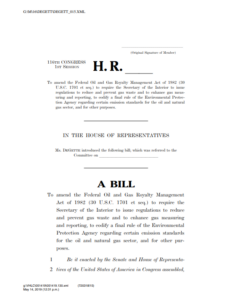US Rep. Diana DeGette introduced legislation to reduce the large amounts of methane pollution and waste that are being released into the atmosphere each year by oil and gas producers across the country. About one-third of all methane released in the US comes from oil and gas operations.
To protect this fuel and prevent it from being wasted or released into the atmosphere, Ms. DeGette’s legislation would require all oil and gas producers in the US to take measures to capture any methane gas that reaches the surface at their well sites, and not burn it off or let it leak into the atmosphere.
Commenting on the legislation, Diana DeGette stated:
If we’re going to be serious about fixing the climate crisis, we have to be serious about curbing the release of methane into the atmosphere. We should be capturing and using this extremely valuable resource, not allowing the worst actors in the oil and gas industry to release it into the atmosphere where it’s going to harm future generations
[smlsubform prepend=”GET THE SAFETY4SEA IN YOUR INBOX!” showname=false emailtxt=”” emailholder=”Enter your email address” showsubmit=true submittxt=”Submit” jsthanks=false thankyou=”Thank you for subscribing to our mailing list”]
The bill – known as the Methane Waste Prevention Act – would mandate oil and gas producers to capture 85% of all gas produced on public lands within three years of enactment, and 99% of all gas produced on such lands within five years of enactment.
The legislation would also ban the venting of any natural gas on public lands, as well as methane flaring at any new wells created two years after the bill is passed.
Essentially, the legislation would reinstate, strengthen and protect two 2016 rules that the Obama administration had established. The first limited the amount of methane that oil and gas producers could release. The second sets similar limits that apply to any new or modified oil and wells in the US.
If approved, the legislation would prevent the EPA from rolling back its version.
Between 2009 and 2015, oil and gas producers released around 462 billion cubic feet of methane into the atmosphere. If captured, this amount would have been enough to supply about 6.2 million households for a year.
According to the EPA, when applied, the rule would would cut about 7.7 to 9 million metric tons of carbon dioxide emissions by 2025. In the same wavelength, the BLM estimated that its rule would keep the equivalent of 4.4 to 4.5 million metric tons of carbon dioxide out of the atmosphere.
A number of US states, including Colorado, North Dakota, Wyoming, Utah and Pennsylvania, have already taken measures to curb venting, flaring and leaks within their boundaries.
See more information in the PDF below
































































